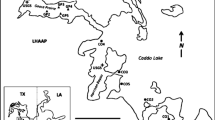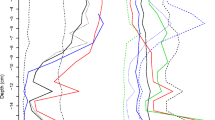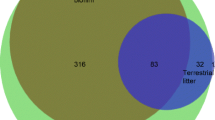Abstract
Ecotoxicological studies usually focus on single microbial species under controlled conditions. As a result, little is known about the responses of different microbial functional groups or individual species to stresses. In an aim to assess the response of complex microbial communities to pollution in their natural habitat, we studied the effect of a simulated lead pollution on the microbial community (bacteria, cyanobacteria, protists, fungi, and micrometazoa) living on Sphagnum fallax. Mosses were grown in the laboratory with 0 (control), 625, and 2,500 μg L−1 of Pb2+ diluted in a standard nutrient solution and were sampled after 0, 6, 12, and 20 weeks. The biomasses of bacteria, microalgae, testate amoebae, and ciliates were dramatically and significantly decreased in both Pb addition treatments after 6, 12, and 20 weeks in comparison with the control. The biomass of cyanobacteria declined after 6 and 12 weeks in the highest Pb treatment. The biomasses of fungi, rotifers, and nematodes decreased along the duration of the experiment but were not significantly affected by lead addition. Consequently, the total microbial biomass was lower for both Pb addition treatments after 12 and 20 weeks than in the controls. The community structure was strongly modified due to changes in the densities of testate amoebae and ciliates, whereas the relative contribution of bacteria to the microbial biomass was stable. Differences in responses among the microbial groups suggest changes in the trophic links among them. The correlation between the biomass of bacteria and that of ciliates or testate amoebae increased with increasing Pb loading. We interpret this result as an effect on the grazing pathways of these predators and by the Pb effect on other potential prey (i.e., smaller protists). The community approach used here complements classical ecotoxicological studies by providing clues to the complex effect of pollutant-affecting organisms both directly and indirectly through trophic effects and could potentially find applications for pollution monitoring.



Similar content being viewed by others
References
Adams, SM, Greeley, MS (2000) Ecotoxicological indicators of water quality: using multi-response indicators to assess the health of aquatic ecosystems. Water, Air and Soil Pollution: Focus 123: 103–115
Ashelford, KE, Fry, JC, Day, MJ, Hill, KE, Learner, MA, Marchesi, JR, Perkins, CD, Weightman, AJ (1997) Using microcosms to study gene transfer in aquatic habitats. FEMS Microbiol Ecol 23: 81–94
Bååth, E, Díaz-Raviña, M, Bakken, LR (2005) Microbial biomass, community structure and metal tolerance of a naturally Pb-enriched forest soil. Microb Ecol 50: 496–505
Borsheim, KY, Bratbak, G (1987) Cell volume to cell carbon conversion factors for bacteriovorous Monas sp. enriched from seawater. Mar Ecol Prog Ser 36: 171–175
Bratbak, G (1985) Bacterial biovolume and biomass estimations. Appl Environ Microbiol 46: 491–498
Charman, DJ, Warner, BG (1992) Relationship between testate amoebae (protozoa, rhizopoda) and microenvironmental parameters on a forested peatland in northeastern Ontario. Can J Zool Rev Can Zool 70: 2474–2482
Clement, WH, Newman, MC (2003) Community Ecotoxicology. Wiley, New York
DePhilippis, R, Sili, C, Paperi, R, Vincenzini, M (2001) Expolysaccharide-producing cyanobacteria and their possible exploitation: a review. J Appl Phycol 13: 293–299
Ekelund, F, Ronn, R, Christensen, S (2001) Distribution with depth of protozoa, bacteria and fungi in soil profiles from three Danish forest sites. Soil Biol Biochem 33: 475–481
Epstein, SS, Shiaris, MP (1992) Size-selective grazing of coastal bacterioplankton by natural assemblages of pigmented flagellates, colorless flagellates, and ciliates. Microb Ecol 23: 211–225
Fernandez-Leborans, G, Olalla Herrero, Y (2000) Toxicity and bioaccumulation of lead and cadmium in marine protozoan communities. Ecotoxicol Environ Saf 47: 266–276
Foissner, W (1999) Soil protozoa as bioindicators: pros and cons, methods, diversity, representative examples. Agric Ecosyst Environ 74: 95–112
Gilbert, D, Amblard, C, Bourdier, G, Francez, AJ (1998) Short-term effect of nitrogen enrichment on the microbial communities of a peatland. Hydrobiologia 374: 111–119
Gilbert, D, Amblard, C, Bourdier, G, Francez, A-J (1998) The microbial loop at the surface of a peatland: structure, function, and impact of nutrient input. Microb Ecol 35: 83–93
Hallberg, KB, Johnson, DB (2005) Microbiology of a wetland ecosystem constructed to remediate mine drainage from a heavy metal mine. Sci Total Environ 338: 53–66
Harithsa, S, Kerkarb, S, Loka Bharathi, PA (2002) Mercury and lead tolerance in hypersaline sulfate-reducing bacteria. Mar Pollut Bull 44: 726–732
Kalin, M, Wheeler, WN, Meinrath, G (2004) The removal of uranium from mining waste water using algal/microbial biomass. J Environ Radioact 78: 151–177
Kozdroj, J, van Elsas, JD (2001) Structural diversity of microbial communities in arable soils of a heavily industrialised area determined by PCR-DGGE fingerprinting and FAME profiling. Appl Soil Ecol 17: 31–42
Lacroix, P, Moncorge, S (1999) Tourbière “Sur les Seignes” (Frambouhans, les Ecorces - 25): Espace Naturel Comtois Doub Nature Environnement. 47
Leborans, GF, Herrero, YO, Novillo, A (1998) Toxicity and bioaccumulation of lead in marine protozoa communities. Ecotoxicol Environ Saf 39: 172–178
Madoni, P, Davoli, D, Gorbi, G, Vescovi, L (1996) Toxic effect of heavy metals on the activated sludge protozoan community. Water Res 30: 135–141
Markert, BA, Breure, AM, Zechmeister, HG (2003) Bioindicators and Biomonitors: Principles, Concepts, and Applications. Elsevier 997, Amsterdam
Martin-Gonzalez, A, Borniquel, S, Diaz, S, Ortega, R, Gutierrez, JC (2005) Ultrastructural alterations in ciliated protozoa under heavy metal exposure. Cell Biol Int 29: 119–126
Mitchell, EAD, Borcard, D, Buttler, AJ, Grosvernier, P, Gilbert, D, Gobat, JM (2000) Horizontal distribution patterns of testate amoebae (Protozoa) in a Sphagnum magellanicum carpet. Microb Ecol 39: 290–300
Mitchell, EAD, Gilbert, D, Buttler, A, Grosvernier, P, Amblard, C, Gobat, J-M (2003) Structure of microbial communities in Sphagnum peatlands and effect of atmospheric carbon dioxide enrichment. Microb Ecol 46: 187–199
Mitsch, WJ, Gosselink, JG (2000) Wetlands, 3rd edn. Wiley, New York
Muhammad, A, Xu, J, Li, Z, Wang, H, Yao, H (2005) Effects of lead and cadmium nitrate on biomass and substrate utilization pattern of soil microbial communities. Chemosphere 60: 508–514
Nguyen-Viet, H, Bernard, N, Mitchell, EAD, Cortet, J, Badot, P-M, Gilbert, D Relationship between testate amoeba (Protist) communities and atmospheric heavy metals accumulated in Barbula indica (Bryophyta) in Vietnam. Microb Ecol, http://dx.doi.org/10.1007/s00248-006-9108-y
Nguyen-Viet, H, Gilbert, D, Bernard, N, Mitchell, EAD, Badot, PM (2004) Relationship between atmospheric pollution characterized by NO2 concentrations and testate amoebae abundance and diversity. Acta Protozool 43: 233–329
Nicolau, A, Martins, MJ, Mota, M, Lima, N (2005) Effect of copper in the protistan community of activated sludge. Chemosphere 58: 605–614
Patterson, RT, Barker, T, Burbidge, SM (1996) Arcellaceans (thecamoebians) as proxies of arsenic and mercury contamination in northeastern Ontario lakes. J Foraminifer Res 26: 172–183
Paulin, JJ (1996) Morphology and cytology in ciliates. In: Hausmann, K, Bradbury, PC (Eds.) Ciliates. Cells as Organisms, Gustav Fischer, Stuttgart, pp 1–40
Pennanen, T (2001) Microbial communities in boreal coniferous forest humus exposed to heavy metals and changes in soil pH—a summary of the use of phospholipid fatty acids, Biolog(R) and 3H-thymidine incorporation methods in field studies. Geoderma 100: 91–126
Piccinni, E, Albergoni, V (1996) Cadmium detoxification in protists. Comp Biochem Physiol C 113: 141–147
Reinhardt, EG, Dalby, AP, Kumar, A, Patterson, RT (1998) Arcellaceans as pollution indicators in mine tailing contaminated lakes near Cobalt, Ontario, Canada. Micropaleontology 44: 131–148
Rudolph, H, Kirchhoff, M, Gliesmann, G (1988) Sphagnum culture techniques. In: Glime JM (Ed.) Methods in Bryology. Proceedings of the Bryological Methods Workshop, Mainz, Hattori Botanical Laboratory, Nichinan, pp 25–34
Shi, W, Becker, J, Bischoff, M, Turco, RF, Konopka, AE (2002) Association of microbial community composition and activity with lead, chromium, and hydrocarbon contamination. Appl Environ Microbiol 68: 3859–3866
Slaveykova, VI, Wilkinson, KJ (2002) Physicochemical aspects of lead bioaccumulation by Chlorella vulgaris. Environ Sci Technol 36: 969–975
Sugiura, K (1996) The use of an aquatic microcosm for pollution effects assessment. Water Res 30: 1801–1812
Suhadolc, M, Schroll, R, Gattinger, A, Schloter, M, Munch, JC, Lestan, D (2004) Effects of modified Pb-, Zn-, and Cd-availability on the microbial communities and on the degradation of isoproturon in a heavy metal contaminated soil. Soil Biol Biochem 36: 1943–1954
Traunspurger, W, Schafer, H, Remde, A (1996) Comparative investigation on the effect of a herbicide on aquatic organisms in single species tests and aquatic microcosms. Chemosphere 33: 1129–1141
Turpeinen, R, Kairesalo, T, Haggblom, MM (2004) Microbial community structure and activity in arsenic, chromium and copper contaminated soils. FEMS Microbiol Ecol 47: 39–50
Utermölh, H (1958) Zur vervollkommnung der quantative phytoplankton-methodik. Mitteilungen aus Institut Verhein Limnologie 9: 1–38
Van den Brink, PJ, Ter Braak, CJF (1999) Principal response curves: analysis of time-dependent multivariate responses of biological community to stress. Environ Toxicol Chem 18: 138–148
Weisse, T, Muller, H, Pinto-Coelho, RM, Schweizer, A, Springmann, D, Baldringer, G (1990) Response of the microbial loop to the phytoplankton spring bloom in a large prealpine lake. Limnol Oceanogr 35: 781–794
Wu, L (2004) Review of 15 years of research on ecotoxicology and remediation of land contaminated by agricultural drainage sediment rich in selenium. Ecotoxicol Environ Saf 57: 257–269
Yeates, GW, Foissner, W (1995) Testate amebas as predators of nematodes. Biol Fertil Soils 20: 1–7
Acknowledgments
We thank Marie-Laure Toussaint for her assistance in Pb analysis, Stéphanie Nicopoulos for determining cyanobacterial species, and Dominique Rieffel for nematode measurement. We express our acknowledgements to Michael Coeurdassier, Jérôme Cortet, and Renaud Scheifler for giving comments to improve the experimental design and helpful discussion throughout the work. Jyrki Jauhianen (University of Helsinki, Finland), Catherine Rausch, and Sandrine Gombert (Muséum National d’Histoire Naturelle de Paris, France) are acknowledged for discussion on Sphagnum growth and supplying references on this issue. We thank the two anonymous reviewers for helpful comments on an earlier version of the manuscript. H. Nguyen-Viet has been supported by the University of Franche-Comté through a temporary lecturer contract (2004–2006) and by the European Science Foundation through an exchange grant (program RSTCB, ESF, 2006). E. Mitchell was at the University of Alaska Anchorage at the onset of this experiment and was later supported by the Swiss contribution to EU project RECIPE (no. EVK2-2002-00269).
Author information
Authors and Affiliations
Corresponding author
Rights and permissions
About this article
Cite this article
Nguyen-Viet, H., Gilbert, D., Mitchell, E.A.D. et al. Effects of Experimental Lead Pollution on the Microbial Communities Associated with Sphagnum fallax (Bryophyta). Microb Ecol 54, 232–241 (2007). https://doi.org/10.1007/s00248-006-9192-z
Received:
Revised:
Accepted:
Published:
Issue Date:
DOI: https://doi.org/10.1007/s00248-006-9192-z




